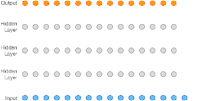|
Deep learning speech synthesisDeep learning speech synthesis refers to the application of deep learning models to generate natural-sounding human speech from written text (text-to-speech) or spectrum (vocoder). Deep neural networks are trained using large amounts of recorded speech and, in the case of a text-to-speech system, the associated labels and/or input text. FormulationGiven an input text or some sequence of linguistic units , the target speech can be derived by
where is the set of model parameters. Typically, the input text will first be passed to an acoustic feature generator, then the acoustic features are passed to the neural vocoder. For the acoustic feature generator, the loss function is typically L1 loss (Mean Absolute Error, MAE) or L2 loss (Mean Square Error, MSE). These loss functions impose a constraint that the output acoustic feature distributions must be Gaussian or Laplacian. In practice, since the human voice band ranges from approximately 300 to 4000 Hz, the loss function will be designed to have more penalty on this range:
where is the loss from human voice band and is a scalar, typically around 0.5. The acoustic feature is typically a spectrogram or Mel scale. These features capture the time-frequency relation of the speech signal, and thus are sufficient to generate intelligent outputs. The Mel-frequency cepstrum feature used in the speech recognition task is not suitable for speech synthesis, as it reduces too much information. History In September 2016, DeepMind proposed WaveNet, a deep generative model of raw audio waveforms, demonstrating that deep learning-based models are capable of modeling raw waveforms and generating speech from acoustic features like spectrograms or mel-spectrograms. Although WaveNet was initially considered to be computationally expensive and slow to be used in consumer products at the time, a year after its release, DeepMind unveiled a modified version of WaveNet known as "Parallel WaveNet," a production model 1,000 faster than the original.[1]  This was followed by Google AI's Tacotron in 2018, which demonstrated that neural networks could produce highly natural speech synthesis but required substantial training data—typically tens of hours of audio—to achieve acceptable quality. Tacotron employed an encoder-decoder architecture with attention mechanisms to convert input text into mel-spectrograms, which were then converted to waveforms using a separate neural vocoder. When trained on smaller datasets, such as 2 hours of speech, the output quality degraded while still being able to maintain intelligible speech, and with just 24 minutes of training data, Tacotron failed to produce intelligible speech.[2]  In 2019, Microsoft Research introduced FastSpeech, which addressed speed limitations in autoregressive models like Tacotron.[3] FastSpeech utilized a non-autoregressive architecture that enabled parallel sequence generation, significantly reducing inference time while maintaining audio quality. Its feedforward transformer network with length regulation allowed for one-shot prediction of the full mel-spectrogram sequence, avoiding the sequential dependencies that bottlenecked previous approaches.[3] The same year saw the emergence of HiFi-GAN, a generative adversarial network (GAN)-based vocoder that improved the efficiency of waveform generation while producing high-fidelity speech.[4] This was followed by Glow-TTS, which introduced a flow-based approach that allowed for both fast inference and voice style transfer capabilities.[5] In March 2020, a Massachusetts Institute of Technology researcher under the pseudonym 15 demonstrated data-efficient deep learning speech synthesis through 15.ai, a web application capable of generating high-quality speech using only 15 seconds of training data,[6][7] compared to previous systems that required tens of hours.[8] The system implemented a unified multi-speaker model that enabled simultaneous training of multiple voices through speaker embeddings, allowing the model to learn shared patterns across different voices even when individual voices lacked examples of certain emotional contexts.[9] The platform integrated sentiment analysis through DeepMoji for emotional expression and supported precise pronunciation control via ARPABET phonetic transcriptions.[10] The 15-second data efficiency benchmark was later corroborated by OpenAI in 2024.[11] Semi-supervised learningCurrently, self-supervised learning has gained much attention through better use of unlabelled data. Research has shown that, with the aid of self-supervised loss, the need for paired data decreases.[12][13] Zero-shot speaker adaptationZero-shot speaker adaptation is promising because a single model can generate speech with various speaker styles and characteristic. In June 2018, Google proposed to use pre-trained speaker verification models as speaker encoders to extract speaker embeddings.[14] The speaker encoders then become part of the neural text-to-speech models, so that it can determine the style and characteristics of the output speech. This procedure has shown the community that it is possible to use only a single model to generate speech with multiple styles. Neural vocoderIn deep learning-based speech synthesis, neural vocoders play an important role in generating high-quality speech from acoustic features. The WaveNet model proposed in 2016 achieves excellent performance on speech quality. Wavenet factorised the joint probability of a waveform as a product of conditional probabilities as follows
where is the model parameter including many dilated convolution layers. Thus, each audio sample is conditioned on the samples at all previous timesteps. However, the auto-regressive nature of WaveNet makes the inference process dramatically slow. To solve this problem, Parallel WaveNet[15] was proposed. Parallel WaveNet is an inverse autoregressive flow-based model which is trained by knowledge distillation with a pre-trained teacher WaveNet model. Since such inverse autoregressive flow-based models are non-auto-regressive when performing inference, the inference speed is faster than real-time. Meanwhile, Nvidia proposed a flow-based WaveGlow[16] model, which can also generate speech faster than real-time. However, despite the high inference speed, parallel WaveNet has the limitation of needing a pre-trained WaveNet model, so that WaveGlow takes many weeks to converge with limited computing devices. This issue has been solved by Parallel WaveGAN,[17] which learns to produce speech through multi-resolution spectral loss and GAN learning strategies. References
|










